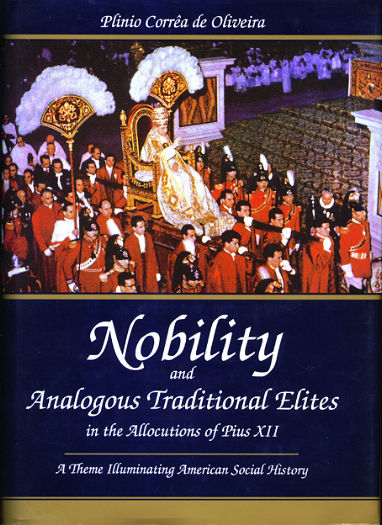Chapter VII
By Plinio Corrêa de Oliveira
In this context, it is easier to understand what the nobility is. It is the class that, unlike others, does not merely have elements of nobility, but is fully noble, entirely noble; it is noble par excellence.
A word about its historical origins is appropriate here.
a. The class of landowners constitutes a military nobility and a political authority
The grand Carolingian empire had been reduced to rubble. Devastating incursions of barbarians, Normans, Hungarians, and Saracens preyed upon its ruins. Attacked on all sides and unable to resist with recourse to the greatly weakened central power of the kings, the populations naturally turned to their respective landowners, demanding that they command and govern them in such calamitous circumstances. Heeding their request, the landowners built fortifications for themselves and for their own.
True to the profoundly Christian spirit of the time, “their own” paternally included not only family members, but the manorial society, formed by the domestic servants, manual workers, and their respective families living on the lord’s lands. All received shelter, food, religious assistance, and military leadership in these fortifications that, with time, became imposing seignorial castles, of which so many still remain. Within these fortifications, peasants safeguarded the movable goods and livestock they had managed to save from the invaders’ greed.
In military action, the landowner and his family were the foremost combatants. Their duty was to command, to be in the vanguard, leading the most daring offensives and the most determined resistance. The condition of military leader and hero was now added to the condition of landowner.
Quite naturally, these circumstances translated during the intervals of peace into local political power over the surrounding lands. This made the landowner a lord, dominus, in the full sense of the word, with the duties of lawmaker and judge. As such, he became a link of union with the king.
b. The noble class: subordinate participation in royal power
Thus, the noble class developed as a subordinate participation in the royal power.
This noble class oversaw the common good of the private sphere, that is, the preservation and improvement of agriculture and livestock raising, from which both nobles and plebeians lived. As the king’s representatives in the area, they were also responsible for the common good of the public sphere. More elevated and universal than the private common good, the public common good was intrinsically noble.
The nobility also participated in the central power of the monarch. The higher nobles were frequently royal councillors. Most of the ministers, ambassadors, and generals were members of the nobility, which thus held posts indispensable to the exercise of the supreme government of the country.
The link between high public office and the nobiliary condition was such that, when the common good required that plebeians be elevated to these posts, they were usually ennobled, frequently with hereditary titles.
Endowed by circumstances with a mission higher than mere farming—namely, the partial overseeing of the salus publica in war and peace—the landowner found himself invested with local powers that normally belonged to the government. Hence he automatically rose to a higher condition. He became a miniature of the king, since his mission was an intrinsic participation in the nobility of the royal mission itself.
From the spontaneous circumstances of history the figure of the landowner-lord emerged. His mission, at once private and noble, was gradually broadened as Christian Europe, increasingly free of afflictions and external threats, enjoyed longer periods of peace. It did not cease to expand for a long time.
c. The regions are defined—the regional common good—the local lord
This new situation enabled people to expand their horizons, thoughts, and activities to gradually vaster fields. Regions were born, shaped by local factors such as geographic characteristics, military necessities, commercial interests, and the influx of pilgrims to popular shrines, students to renowned universities, and merchants to famous fairs.
Psychological affinities also contributed to the formation of these regions. These affinities resulted from a long past of fighting common enemies, a similarity of language, customs, artistic expressions, and so on.
The regional common good thus encompassed the several local common goods, and was therefore higher and nobler.
The direction of this regional common good naturally befell some higher lord, owner of vaster dominions, more powerful, more representative of the whole region, and therefore more capable of uniting the various areas without harm to their autonomies, whether for reasons of war or peacetime pursuits.
The regional lord was a miniature of the king in the region. His station entailed rights and duties intrinsically nobler than those of the landowner-lord, a miniature of the king in the locale. Therefore, the feudal lord (the noble landowner-lord whose numerous workers participated in his property rights through a link similar to today’s emphyteusis127) owed the regional lord a vassalage analogous to that rendered by the regional lord to the king. This resulted in the formation of a nobiliary hierarchy at the top of the social hierarchy.
d. The medieval king
Of course, in principle none of this existed independently of or in opposition to the king, the supreme symbol of the people and the nation. On the contrary, it existed under his tutelar aegis and supreme power in order to preserve on his behalf this great organic whole of autonomous regions and locales that was the nation.
Even when the de facto royal power was at its weakest, the unitary monarchical principle was never contested. A nostalgia for royal unity—and even, in many places, for the Carolingian imperial unity, which embraced all of Christendom—never ceased to exist throughout the Middle Ages. As the kings gradually recovered the means to exercise a power that effectively encompassed the whole realm and represented its common good, they did so.
This immense consolidation, definition, and organization, first at the local level and then at the regional level, followed by a no lesser re-articulation of the national unity and authority, did not occur without strife. Here and there excessive claims, formulated in a unilateral and passionate way, were made both by representatives of legitimate autonomies and by promoters of necessary unifications. This generally led to feudal wars that, at times, were long and intertwined with international conflicts.
Such was the heavy price men paid because of Original Sin, actual sins, and softness or complacency, when not surrender, in the struggle against the spirit of evil.
Despite these obstacles, the profound meaning of the history of feudalism and the nobility cannot be understood without considering what was said above. This is how the society and state of the Middle Ages were modeled.
In some places the origin and development of the feudal regime varied according to the local circumstances. The exemplification above, therefore, does not apply to all European states. Many of its elements, however, are present in the history of kingdoms that did not have a feudal regime in the full sense of the word, as, for example, Portugal and Spain.128
e. The feudal regime: a factor of unity or division?—The experience of contemporary federalism
Many historians see the feudalism of certain regions of Europe and the para-feudal agrarian arrangements of others as dangerously divisive.
Experience shows, however, that autonomy per se is not necessarily a factor of disunity.
No one today sees divisive factors in the autonomy of the states forming the federal republics on the American continents. On the contrary, one sees flexible, resilient, and fruitful relationships. One sees an intelligently planned union. Regionalism does not mean hostility among the parts, or between the parts and the whole, but harmonious autonomy and spiritual and material richness, both in the features common to all the regions and in the peculiarities of each.
Footnotes:
(127) A juridical term meaning a perpetual right to the use of land that is the property of someone else.
(128) Cf. José Mattoso, A Nobreza Medieval Portuguesa (Lisbon: Editorial Estampa, 1981), pp. 27-28, and Enciclopedia universal ilustrada, Espasa-Calpe, Vol. 21, pp. 955, 958, and Vol. 23, p. 1139.
Plinio Corrêa de Oliveira, Nobility and Analogous Traditional Elites in the Allocutions of Pius XII: A Theme Illuminating American Social History (York, Penn.: The American Society for the Defense of Tradition, Family, and Property, 1993), Chapter VII, Pg. 94 – 98.











